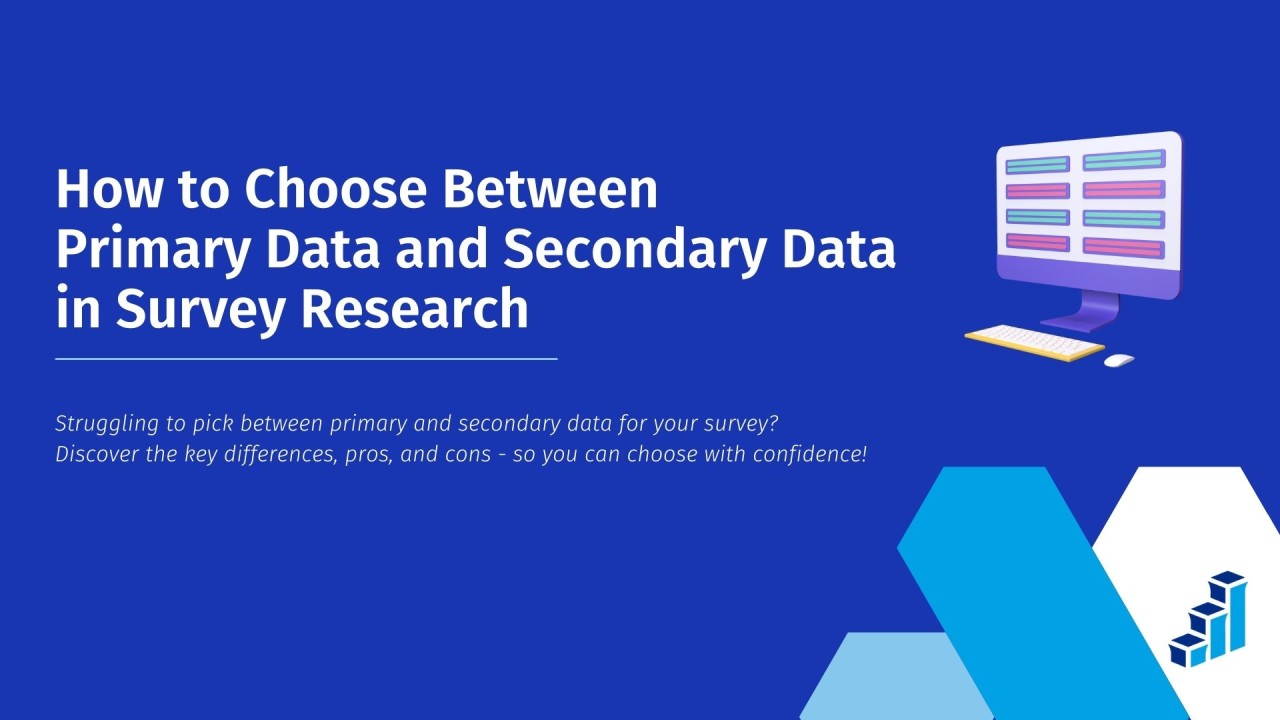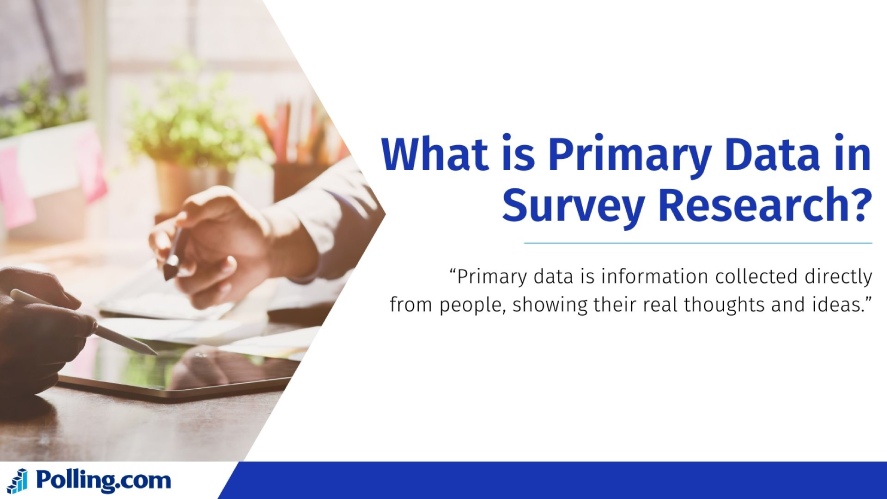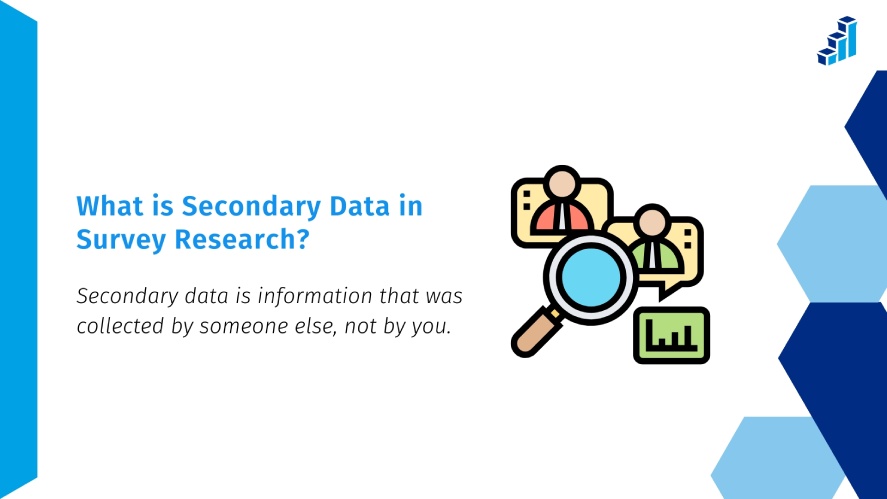
Primary Data and Secondary Data in Survey Research
Survey research is a way to collect information from a group of people to find out what they think, do, or feel about something. Through surveys, we can understand and make conclusions based on the answers we get.
To create a successful survey, it’s essential to use data appropriately. There are two types of data you can collect: primary data and secondary data.
Primary data comes directly from people through surveys, interviews, or watching what they do.
Meanwhile, secondary data comes from things that already exist, like books, reports, or old studies.
The success and reliability of your research largely depend on selecting the right type of data that aligns with your research objectives.
Thus, between survey research using primary data or secondary data, you need to determine which type of survey will ensure accurate results and align with the set objectives.
What is Primary Data in Survey Research?
Primary data is information collected directly from people, showing their real thoughts and ideas. This kind of data is updated and will fit the purpose of your research.
To gather your data, you need to conduct a survey, and there are different ways to collect primary data.
One way is through online surveys, which help gather answers from many people quickly and easily, such as by giving them some survey answer choices.
Another way is interviews, where you talk to people directly to learn more details.
Also, focus groups are used, where a small group of people discuss a topic to share different ideas and opinions.

In addition to understanding how to collect primary data, it’s also useful to know its benefits.
First, primary data is accurate because you collect the information directly from people at your request.
The data you receive will be new and come directly from the people you asked, so it will not become outdated.
Second, it is relevant to your specific research goals because you can ask questions that match exactly what you want to find out.
However, collecting primary data can be challenging for a few reasons.
The first challenge to mention is the cost because doing surveys, interviews, or focus groups often needs money for materials, tools, or even the people helping with the research.
The next challenge is that it takes a lot of time.
You have to spend time planning the survey questions, finding people to answer, and then waiting for their responses. After that, you still need more time to look at all the answers and understand the information.
This can be a long survey process, especially if the research involves many people or multiple areas of research.
What is Secondary Data in Survey Research?
Secondary data is information that was collected by someone else, not by you. The data is already there, and you can use it without having to ask people questions or do a new survey.
So, there are many places where you can find secondary data.
For example, government databases are a good place.
These have information about things like how many people live in a country or how much money people make, etc.
Another place is industry reports, which tell us about businesses and markets.
You can also find data in academic papers written by smart people at schools and universities.

Additionally, to help you find out what are good statistical tools for surveys, we’d recommend using Polling.com – a popular and reliable tool for secondary data.
Like primary data, secondary data also has outstanding advantages.
First of all, secondary data is helpful because it saves time.
You don’t need to spend hours asking people questions. The data is already collected, so you just have to find and use it.
Secondly, it also saves money because you don’t have to pay to collect new information.
Next, you can look at old data and see how things have changed over time.
While secondary data is helpful, there are some problems. Sometimes, the data is not exactly what you need because it was collected for a different reason. It might not answer your question perfectly.
Also, the data could be outdated, which means it doesn’t show what is happening right now.
That’s why you need to check the data before choosing secondary data as your method. If the information is still useful, secondary data is the fastest way to your final result.
Key Differences Between Primary Data and Secondary Data
Primary and secondary data are both essential for research, but they have many differences.
The necessary differences to mention are cost, time, accuracy, relevance, and flexibility. You should have a clear perspective to distinguish which method is the most suitable for your project.
The table below shows the key differences between primary and secondary data to help you understand them better.
| Factors | Primary Data | Secondary Data |
|---|---|---|
| Cost | Expensive because you have to collect the data yourself (pay for surveys, tools, etc.) | Less expensive because the data is already collected |
| Time | Takes a lot of time to collect data | Saves time since it’s already available |
| Accuracy | Very accurate because you control how it’s collected | May not be as accurate since it was collected by others |
| Relevance | Directly related to your research | Might not fit your research perfectly |
| Flexibility | You decide what to collect and how | You can’t change the data |
After all, primary data and secondary data are different methods of data collection. The value they bring depends on your research purpose.
Choosing the right type of data will bring great value, while the wrong choice will limit its effectiveness.
When to Use Primary Data and Secondary Data in Survey Research
In survey research, knowing when to use primary data and when to use secondary data is crucial. Each type of data is useful in different situations, depending on what kind of information you need.
Research Objectives
When deciding between primary and secondary data, the first thing to consider is your research objectives.
You should think carefully about what you are trying to learn or discover.
If your goal is to find new, specific information that no one has collected before, primary data is the best choice.
On the other hand, if your research objective is to understand general trends or patterns, secondary data can be helpful.
In case you are studying how people’s eating habits have changed over the years, you can use data from past survey reports or studies.
This saves you time because the information is already collected.
In short, if you need specific, new information, go with primary data. If you are looking for general information that has already been collected, secondary data is a good choice.
Budget
Your budget is another big influential factor.
Collecting primary data can be expensive because you need to pay for things like survey tools for research, printing questionnaires, or even hiring people to help collect data.
Secondary data, however, is usually less expensive.
Since the data is already collected, you don’t have to pay to gather it.

Many government reports, research papers, and online databases are free or cost very little.
That’s why secondary data is a good option if you don’t have much money to spend.
Thus, if you have a big budget, you can choose primary data to get fresh, specific information. But if your budget is small, secondary data can help you save money while still giving you useful information.
Time Constraints
Time is also a crucial factor to consider when making decisions.
Firstly, collecting primary data can take a lot of time. You need to plan your survey, create questions, find people to answer them, and then wait for the responses. After that, you have to organize and study the answers.
The entire process may require several weeks or even months to complete.
If you don’t have much time, secondary data is a faster choice.
The information has already been gathered, so you can use it right away.
To have your data, you only need to find it in reports, articles, or online databases.
Just imagine you only have a few days to finish your research project, using secondary data will save you time.
Available Resources
Available resources mean the tools, people, and materials you have to help with your research.
If you have access to survey tools, computers, and people who can help collect data, it’s easier to gather primary data.
However, if you don’t have many resources, secondary data is a better choice.
You don’t need special tools or a big team because the information is already there. You just need a computer or books to find the data.
Examples and Scenarios
In survey world, primary and secondary data are used in different situations depending on the goal of the research.
The following situations will help you understand when to use each type of data.
Primary Data
Imagine a company is planning to launch a new product, like a new type of snack.
After launching the first shipments, the company wants to know what customers think about the taste, packaging, and price.
Since this is a brand-new product, there is no existing information about it.
So, the company needs to collect fresh opinions directly from customers.
They can collect customer opinions by asking people to fill out surveys with their feedback.
In this case, using primary data makes more sense because the company needs new, specific information about its product.
They can’t rely on old data since the product has never been sold before.
Secondary Data
Suppose the company wants to grow its business by selling a new product in a different market.
To make smart decisions, the company needs to understand what customers like and what products are popular.
Instead of asking people directly, they can look at information that market research companies have already collected, like market trends.
For instance, they can use the best government survey report to see which smartphones are selling well and research papers to learn about customer preferences to check how competitors are doing.
It helps save time and money, and in this case, you can understand it’s a smart choice for planning your strategy.
How to Decide: Primary Data or Secondary Data in Your Survey Research
Primary data is best when you need specific, up-to-date information that no one has collected before, ensuring the results are both accurate and perfectly tailored to your needs.
On the other hand, secondary data is useful when you need general information that has already been collected.
Before deciding between two of them, consider your research question: when you need fresh, detailed, and specific information, primary data is your best bet.
Or, when ample existing information already covers your topic, tapping into secondary data is the smarter choice.
Sometimes, researchers use both to get the best results. So, using the right type of data will help you do your research more effectively.
How Polling.com Can Help With Survey Research
Doing survey research can be a big task, but having the right help makes it much easier.
To learn how to get survey responses effectively, start with Polling.com. The tool has lots of features that make surveys simple.
You can use it to collect primary data, which is new information you find yourself, and secondary data, which is information that other people have already gathered.
For primary data, Polling.com lets you create your surveys. You can ask questions about anything you want. The app has easy-to-use survey tools, so you don’t need to be an expert to make a good survey.

You can choose different types of questions, like multiple-choice or short answers. You can also send your survey to many people quickly!
For secondary data, Polling.com gives you access to reliable data sources.
If you want to know about voting trends, public opinions, or past surveys, Polling.com has all that data ready for you.
Having all the data readily available spares you the hassle of manual collection, letting you focus on more important tasks.
So, why is Polling.com special?
- It’s easy to use, even for beginners.
- It has tools to help you create surveys fast.
- It gives you access to trusted and reliable data.
- You can collect answers from people all over the world.
For anyone working on a project or who wants to learn how to conduct a survey research project, Polling.com is the perfect starting point. It streamlines the process, making survey research efficient, enjoyable, and swift.
Try Polling.com today and discover just how effortless collecting survey data can be!
Conclusion
In conclusion, understanding the differences between primary and secondary data is crucial for survey research.
Primary data helps when you need new, specific information, while secondary data is useful when you need existing information quickly and easily.
Choosing the right type of data depends on your research goals—think carefully about what information you need and why.
Finally, to make your survey research easier and more effective, Polling.com is a great tool. Start using Polling.com from now on to collect the best data for your research!
